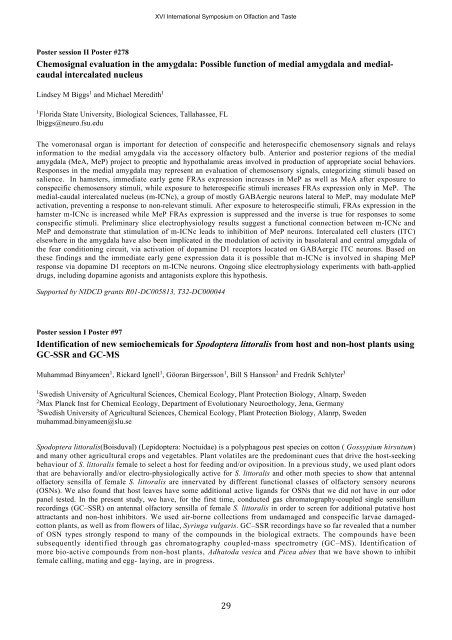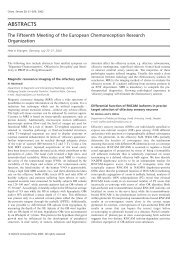XVI International Symposium on Olfaction and Taste - ecro
XVI International Symposium on Olfaction and Taste - ecro
XVI International Symposium on Olfaction and Taste - ecro
Create successful ePaper yourself
Turn your PDF publications into a flip-book with our unique Google optimized e-Paper software.
<str<strong>on</strong>g>XVI</str<strong>on</strong>g> <str<strong>on</strong>g>Internati<strong>on</strong>al</str<strong>on</strong>g> <str<strong>on</strong>g>Symposium</str<strong>on</strong>g> <strong>on</strong> Olfacti<strong>on</strong> <strong>and</strong> <strong>Taste</strong><br />
Poster sessi<strong>on</strong> II Poster #278<br />
Chemosignal evaluati<strong>on</strong> in the amygdala: Possible functi<strong>on</strong> of medial amygdala <strong>and</strong> medial-<br />
caudal intercalated nucleus<br />
Lindsey M Biggs 1 <strong>and</strong> Michael Meredith 1<br />
1 Florida State University, Biological Sciences, Tallahassee, FL<br />
lbiggs@neuro.fsu.edu<br />
The vomer<strong>on</strong>asal organ is important for detecti<strong>on</strong> of c<strong>on</strong>specific <strong>and</strong> heterospecific chemosensory signals <strong>and</strong> relays<br />
informati<strong>on</strong> to the medial amygdala via the accessory olfactory bulb. Anterior <strong>and</strong> posterior regi<strong>on</strong>s of the medial<br />
amygdala (MeA, MeP) project to preoptic <strong>and</strong> hypothalamic areas involved in producti<strong>on</strong> of appropriate social behaviors.<br />
Resp<strong>on</strong>ses in the medial amygdala may represent an evaluati<strong>on</strong> of chemosensory signals, categorizing stimuli based <strong>on</strong><br />
salience. In hamsters, immediate early gene FRAs expressi<strong>on</strong> increases in MeP as well as MeA after exposure to<br />
c<strong>on</strong>specific chemosensory stimuli, while exposure to heterospecific stimuli increases FRAs expressi<strong>on</strong> <strong>on</strong>ly in MeP. The<br />
medial-caudal intercalated nucleus (m-ICNc), a group of mostly GABAergic neur<strong>on</strong>s lateral to MeP, may modulate MeP<br />
activati<strong>on</strong>, preventing a resp<strong>on</strong>se to n<strong>on</strong>-relevant stimuli. After exposure to heterospecific stimuli, FRAs expressi<strong>on</strong> in the<br />
hamster m-ICNc is increased while MeP FRAs expressi<strong>on</strong> is suppressed <strong>and</strong> the inverse is true for resp<strong>on</strong>ses to some<br />
c<strong>on</strong>specific stimuli. Preliminary slice electrophysiology results suggest a functi<strong>on</strong>al c<strong>on</strong>necti<strong>on</strong> between m-ICNc <strong>and</strong><br />
MeP <strong>and</strong> dem<strong>on</strong>strate that stimulati<strong>on</strong> of m-ICNc leads to inhibiti<strong>on</strong> of MeP neur<strong>on</strong>s. Intercalated cell clusters (ITC)<br />
elsewhere in the amygdala have also been implicated in the modulati<strong>on</strong> of activity in basolateral <strong>and</strong> central amygdala of<br />
the fear c<strong>on</strong>diti<strong>on</strong>ing circuit, via activati<strong>on</strong> of dopamine D1 receptors located <strong>on</strong> GABAergic ITC neur<strong>on</strong>s. Based <strong>on</strong><br />
these findings <strong>and</strong> the immediate early gene expressi<strong>on</strong> data it is possible that m-ICNc is involved in shaping MeP<br />
resp<strong>on</strong>se via dopamine D1 receptors <strong>on</strong> m-ICNc neur<strong>on</strong>s. Ongoing slice electrophysiology experiments with bath-applied<br />
drugs, including dopamine ag<strong>on</strong>ists <strong>and</strong> antag<strong>on</strong>ists explore this hypothesis.<br />
Supported by NIDCD grants R01-DC005813, T32-DC000044<br />
Poster sessi<strong>on</strong> I Poster #97<br />
Identificati<strong>on</strong> of new semiochemicals for Spodoptera littoralis from host <strong>and</strong> n<strong>on</strong>-host plants using<br />
GC-SSR <strong>and</strong> GC-MS<br />
Muhammad Binyameen 1 , Rickard Ignell 1 , Göoran Birgerss<strong>on</strong> 1 , Bill S Hanss<strong>on</strong> 2 <strong>and</strong> Fredrik Schlyter 3<br />
1 Swedish University of Agricultural Sciences, Chemical Ecology, Plant Protecti<strong>on</strong> Biology, Alnarp, Sweden<br />
2 Max Planck Inst for Chemical Ecology, Department of Evoluti<strong>on</strong>ary Neuroethology, Jena, Germany<br />
3 Swedish University of Agricultural Sciences, Chemical Ecology, Plant Protecti<strong>on</strong> Biology, Alanrp, Sweden<br />
muhammad.binyameen@slu.se<br />
Spodoptera littoralis(Boisduval) (Lepidoptera: Noctuidae) is a polyphagous pest species <strong>on</strong> cott<strong>on</strong> ( Gossypium hirsutum)<br />
<strong>and</strong> many other agricultural crops <strong>and</strong> vegetables. Plant volatiles are the predominant cues that drive the host-seeking<br />
behaviour of S. littoralis female to select a host for feeding <strong>and</strong>/or ovipositi<strong>on</strong>. In a previous study, we used plant odors<br />
that are behaviorally <strong>and</strong>/or electro-physiologically active for S. littoralis <strong>and</strong> other moth species to show that antennal<br />
olfactory sensilla of female S. littoralis are innervated by different functi<strong>on</strong>al classes of olfactory sensory neur<strong>on</strong>s<br />
(OSNs). We also found that host leaves have some additi<strong>on</strong>al active lig<strong>and</strong>s for OSNs that we did not have in our odor<br />
panel tested. In the present study, we have, for the first time, c<strong>on</strong>ducted gas chromatography-coupled single sensillum<br />
recordings (GC–SSR) <strong>on</strong> antennal olfactory sensilla of female S. littoralis in order to screen for additi<strong>on</strong>al putative host<br />
attractants <strong>and</strong> n<strong>on</strong>-host inhibitors. We used air-borne collecti<strong>on</strong>s from undamaged <strong>and</strong> c<strong>on</strong>specific larvae damagedcott<strong>on</strong><br />
plants, as well as from flowers of lilac, Syringa vulgaris. GC–SSR recordings have so far revealed that a number<br />
of OSN types str<strong>on</strong>gly resp<strong>on</strong>d to many of the compounds in the biological extracts. The compounds have been<br />
subsequently identified through gas chromatography coupled-mass spectrometry (GC–MS). Identificati<strong>on</strong> of<br />
more bio-active compounds from n<strong>on</strong>-host plants, Adhatoda vesica <strong>and</strong> Picea abies that we have shown to inhibit<br />
female calling, mating <strong>and</strong> egg- laying, are in progress.<br />
29



